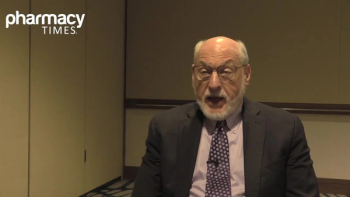
In Addition to Workload and Staffing, Automation Can Help Pharmacies Tackle Pricing Pressures
Automation has long been viewed as a tool to help improving staffing and workload, but Swanson said it can help a multitude of other challenges, as well.
In an interview with Pharmacy Times, Jeff Swanson, senior vice president of sales and marketing at JFCRx, discussed what the future of automation looks like in pharmacies. Automation has long been viewed as a tool to help improving staffing and workload, but Swanson said it can help a multitude of other challenges, as well.
Q: Pharmacies today are facing a multitude of challenges—increased workloads, staffing shortages, pricing pressures, and regulatory compliance requirements, among others. How can automation help pharmacies meet these challenges?
Jeff Swanson: Yeah, it's definitely gotten harder in the pharmacy market over the last couple of years, especially. It's been getting more and more challenging for them for all the reasons you just mentioned, but automation plays a unique role in that in the fact that it allows you to reassign staff as needed. So, if I have a pharmacy tech position that's open for…just filling prescriptions, can I reassign that person to a different, more value-added role? Or is it a position that because of bringing the automation in, I maybe don't have to fill that position anymore? So, in automation, in the grand scheme of pharmacy, it's really looked at in kind of 2 ways. The first one is, can I use it to expand my revenue opportunities and look for additional business lines that I can reach out into? And then secondly, in my current operation that I'm doing, are there efficiencies that I can gain through automation that will help me be more profitable or, again, expand into different areas of the business that maybe I'm not playing in right now? So that's usually the 2 aspects that we're talking to customers about around automation.
Q: Finding and implementing new revenue streams is always a focus for pharmacies. How does automation play a role here?
Jeff Swanson: Yeah, so historically, automation has always been seen as kind of the efficiency gains. So, if I'm doing a workload, how can I accomplish this with the least amount of cost as possible to my staff? And I think in the forefront, that's still where automation plays today in most people's minds, it's that efficiency piece. But the new revenue streams for pharmacies [are] whether that's getting away from PBM-type revenue or looking just for additional lines of business to help them grow, with the reimbursement issues that are going on currently. You know, it lets them look into really the data behind the automation and the analytics behind it now. So, you get this patient profile, and you can look at dispense history, medication types, this onslaught of information that you get from servicing these customers, and now you can transfer that into MTM-type programs, you can start looking into clinical billing type solutions. Are there, again, non-PBM revenue sources that as a pharmacy, I can be acting on that historically I haven't expanding into? Long-term care at home is a very popular place that people are playing right now that, historically, some pharmacies haven't looked at. And the COVID-19 pandemic showed that in a lot of different ways because the typical long-term care patient may be trying to stay at home longer now. So how do we reach that? How do we reach that patient outside of a traditional pharmacy setting versus a traditional closed-door setting that normally we wouldn’t have been able to grab that revenue stream. So, automation puts you in a position where you can have the right resources to fill the way that you need to [in order] to hit those patients. But at the same time, it also reduces the workload that you need to do with your current staff to allow you to explore other opportunities, that could be a potential for the pharmacy as well.
Q: How can automation play a role in pricing challenges?
Jeff Swanson: Yeah, so when we're looking at automation, I think there's really 2 main aspects of that. The first one is in terms of your staff allocation, again, so if I can do more with less, which is always what every organization is trying to do right now, either having that been forced on to them or just the goal through Lean Six Sigma and that type of lean processing that they look at. So, if I can have a piece of automation and accomplish my workload with less staff, obviously, I'm going to be able to have a better margin and cost associated with my production time. Now, that doesn't mean to scare pharmacies into thinking that if you buy automation, you're going to have to get rid of staff members, because staffing is extremely difficult right now. And if you have good employees, you don't want to have to get rid of them just because you bring in automation. So, I think one of the misconceptions around it is to help pay for this automation, I have to lower my staff number. Again, it's reallocation. Are there activities that you could be doing with those staff members that today you can't currently do? So instead of having to add headcount, I can man activities with the current headcount I have, because of automation entering into my workflow. Or if I have existing automation, looking at new, more efficient automation opportunities that are out there.
The other side of it that really comes into play is in terms of your inventory cost. And if you are using automation in a very efficient manner, you can really focus on just-in-time ordering of your inventory. There are robust challenges with this as well, because of drug shortages and supply chain issues that are still out there in the industry, but [we can] use the analytics of automation and look at your cycle fill scheduling and have an understanding of what patients are going to need on what day and what those medication needs are. So, I can be ordering, you know, today or, you know, 1 or 2 days ahead of time for the medication that I know I'm going to be filling in that next production run. I can streamline my ordering process. And then again, I can be looking for the best cost medication, best effective medication, versus just what's available at that time because I have the information coming from my automation system.
Q: Can you give specific examples of how automation and related workflows can help pharmacies save on labor costs?
Jeff Swanson: Yeah, I think just to give you an example of it, we were in a pharmacy where they were filling blister cards by hand. And by being able to put automation in the multidose blister card machine, they were able to go from having 3 technicians filling their multidose blister cards by hand over the course of a week, to having 1 technician run the automation throughout the production day and reassigning those 2 other techs to different lines of the business that weren't just going to be sitting there filling the multidose blister cards. So, whether it's reassigning technicians to different areas of the pharmacy, putting them into a different workflow that may be upstream or downstream from that production process, or just, again, reallocating. If I have existing technology and there's a more efficient model out there, maybe going from 2 full-time employees running my current automation to my new automation only needs 1 full time tech to be running it, those are really the conversations that we have with our pharmacy customers on top of the workflow pieces. So, automation going into a site isn't the final solution. Having and making sure that you know you have a pharmacy partner as the vendor around the automation, who can help you with the workflow, is the second half of that equation.
Q: Technicians also benefit with the implementation of automation. How are their workflows and workloads improved and what does this mean for their role in the pharmacy?
Jeff Swanson: So, again, I think the idea behind automation is allowing the person who's in the role that they're in to do the job that they were assigned to do. Automation is always going to have a human component to it, there's never a fully robotic solution that's going to completely remove that human element from the workflow. So, we're looking into solutions where you can have the most efficient way of doing that, whether that's using API analytics—or even AI analytics now is starting to become more prevalent in the industry—to help your technicians and your staff in general make determinations on what is the most efficient use of time for the day. It allows them to do what they're there to do, which is producing packaged medications for customers. So, you know, in the current state of the pharmacy world, if you have automation, you typically have an approval process going from the order coming into your pharmacy system, it gets approved, it gets sent to a machine, and then the technician is making a determination of if and when they decide to run the order, and what order the patients are going to be running in. As you continue to move forward and as the industry is changing, you're looking into solutions of how the technology can be making the best decision for you. And that, again, ties into what's the capacity of my machine? What inventory do I have available? What's my delivery schedule? What's my patient needs? All these things that a technician typically doesn't have in the back of their head, they're not going to know the entire inventory of the machine, they're not going to know offhand exactly what delivery schedule they need to do. So, instead of making the technician take the time to dive into that side of it, [we’re] having the technology just push it to you. And when I have orders 1, 2, and 3 in the system, those are the right orders to be sent in at the right time. It makes me more efficient as an organization. It makes my technicians more efficient. And again, if I can go from 10 hours of production time over the course of a day and bring that down to 8 or 7 due to efficiency gains, what does that allow me to do as an organization and what does that allow my technicians to do on top of that, again, just that normal day-to-day production side of the work. So, empowering them through technology is really the focus I have, and the industry has seems to have, because you want to empower them to do their jobs but also make it as efficient as possible for them.
Q: Advanced verification technologies improve accuracy and patient safety. Can you talk a little about this technology and what it means for pharmacy operations?
Jeff Swanson: Yeah, so the verification side of the industry has been around for a while now. But it's, again, probably the most impactful side to the workflow now, because you're dealing with pharmacists’ time on the verification side of it. And then that ties into the most expensive labor you have in your pharmacy, typically. But also, it's that final verification before it leaves your pharmacist or pharmacy and enters patient hands. So, this is, you know, a safety issue. It's a profitability issue. There's a lot of concern when it comes to inspection. The verification technology has evolved, even though it's been in the industry for a decade-plus now at this point. And what it's really evolving to is, how can we embrace it to allow that same concept we talked about earlier, doing more with less? And in the past, you used to have to have a pharmacist on site, at each location that you were packaging in. And they were sitting at a workstation, and they were verifying pills at that workstation, and they could go nowhere else to do it. The world has changed in the last in the last few years, pretty rapidly. And you're now getting into remote workflow. Is there a possibility that a pharmacist can be, depending on state boards and regulations, of course, that they have the ability to sit in pharmacy number 1 and verify not only the pills that were packaged at pharmacy 1, but also that were packaged at pharmacy 2, because they have the ability to be connected through web-based systems now. So, as we're evolving the workflow of the inspection to not only be safer and more accurate, we're also looking at how we can make it more efficient for these pharmacists so that they are able to support their entire organization. And this goes back into the staffing issues.
I just talked to a pharmacist this past week who's had 2 pharmacies in Nebraska, and he's had 2 pharmacist positions open since February of last year that he has not been able to hire for. And there they have a second location, so he's floating between 2 locations with the pharmacists that he has. Whereas if he’s able to do this, maybe he can have 1 pharmacist at each location with a third that is remote checking between the 2. And does that allow him now to not have to hire to hire 1, or even work with the staff he has until he can hire, so that he doesn't have to worry about burnout. He doesn't worry about his pharmacists being overworked because they're traveling between locations. So, for me, it's just looking into the reality of what are these pharmacies dealing with and how can we use the technology to fix the real-life issues? Versus sometimes it's abstract, it's the idea of what we can do. I always like to say, you know, what are we actually hearing from customers and what can we do to fix those solutions?
Q: Is there anything you’d like to add?
Jeff Swanson: No, I think, again, the most important part, as we were talking through this, is the technology is great. And technology has been around essentially forever in pharmacies now, but as I mentioned earlier, that's one portion of the problem. The second one is the vendor partnership that you have, and knowing what is their path forward? And what does their development process look like? The pharmacy world is changing every single day right now and if you have the right vendor, they're going to be looking down the road with you and they're going to be adjusting their automation to, again, fix the issues that you're actually experiencing and have an understanding and a plan of the operations in the workflow. Automation for the sake of automation helps with some of the problems, but plugging in a piece of automation isn't going to immediately drive revenue, it's not immediately going to fix your workflow issues and your staffing issues. But partnering with the right vendor will relieve those issues down the road, as well. So, I think it's a 2-part piece: it's technology and choosing the right vendor.
Newsletter
Stay informed on drug updates, treatment guidelines, and pharmacy practice trends—subscribe to Pharmacy Times for weekly clinical insights.



















































































































































































































